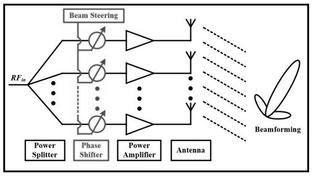Phase Shifter Types: Precision, MIC, Reciprocal & Non-Reciprocal
Advertisement
A phase shifter is a two-port passive device that introduces a variable change in the phase of a transmitted wave passing through it.
It can be implemented by placing a lossless dielectric slab within a waveguide, oriented parallel to and at the position of maximum electric field (E-field). The dielectric slab is typically tapered at both ends to minimize reflections.
Various types of phase shifters exist, including:
- Precision phase shifter
- MIC (Microwave Integrated Circuit) phase shifter
- Reciprocal phase shifter
- Non-reciprocal phase shifter

The change in wave velocity through the slab creates a differential phase shift. As shown in the figure, adjusting the length allows for different phase shifts to be achieved. The S-matrix of an ideal phase shifter is given by:
Precision Phase Shifter
A precision phase shifter can be designed as a rotary type. It’s composed of the following parts:
- Circular-to-rectangular waveguide transitions at both ends.
- A circular waveguide section with a lossless dielectric plate of half-wavelength (180 degrees) in the middle.
- Quarter-wavelength (90 degrees) plates positioned between the waveguide transitions and the half-wave plate.
The mode of the rectangular waveguide becomes after passing through the transition at the end. An appropriate phase shift is achieved after the wave traverses the two quarter-wave sections and the rotary half-wave section in the middle.
MIC Phase Shifter
MIC phase shifters are built using ferrite materials.
Ferrite materials typically have a dielectric constant between 9 and 16 and a loss tangent less than 0.001. The propagation constant of electromagnetic (E-M) waves can be altered by varying the magnitude and direction of a static magnetic field. This principle underlies the operation of the MIC phase shifter.
Ferrite phase shifters are mainly of two types: reciprocal and non-reciprocal. Each of these types has analog and digital sub-categories.
In the analog version, the phase is controlled by varying either the magnitude or the direction of the magnetization vector using an applied static magnetic field. In the digital version, the phase is controlled by using ferrite material of high remanence by latching dielectric substrate using a current pulse to change direction of the DC magnetic field.
Advertisement
 RF
RF


